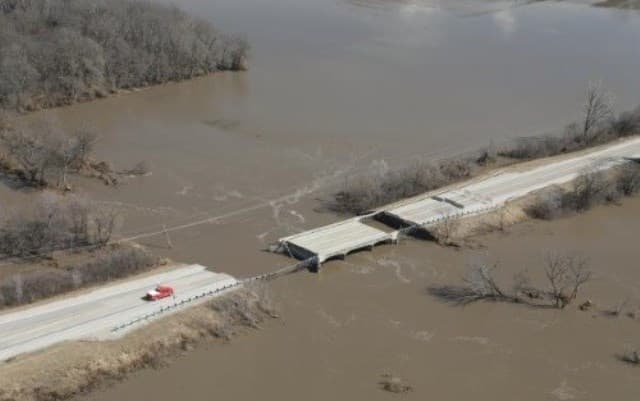A “bomb cyclone” that struck the Midwest earlier this month, causing major flooding across Nebraska and parts of Iowa and Missouri, is responsible for more than $1 billion in property losses, as well as damage to highways, roads and bridges, according to reports from those states.
The Nebraska Department of Transportation stated that more than 1,500 miles of roads were closed at the height of the flooding on March 18, with 15 major highway bridges completely washed out or severely damaged as a result of the high waters.
The Nebraska Emergency Management Agency (NEMA) reported that as of March 20 more than 80 percent was under emergency declaration orders, including 77 counties, four tribal nations and five special government areas such as unincorporated townships.
“This past week will forever be remembered for the historic, devastating flooding our state experienced,” Nebraska Gov. Pete Ricketts said in a March 19 statement. “In scope of reach, we believe it is the most widespread natural disaster in our state’s history.”
The flooding, caused by heavy rains occurring simultaneously with melting snow, was exacerbated by chunks of ice swept along by the waters that damaged buildings and infrastructure, NEMA noted.
Nebraska National Guard helicopter crews resorted to dropping hay to cattle stranded by the high waters to ensure they didn’t starve.
The Midwest flooding also triggered an emergency declaration by the Federal Railroad Administration on March 19.
“The large amounts of snow and ice resulting from the region’s recent winter weather have melted and swelled rivers, creeks and other inland bodies of water throughout the region,” the agency said in its statement. “Historic flooding throughout the region [witnessed] rivers rising to historic levels in over 40 locations, causing power outages and breached dams and levees.”
The Iowa Department of Transportation closed sections of Interstate 29 and established detours on March 15 in cooperation with the Missouri Department of Transportation and other public agencies, and placed restrictions on parts of Interstate 680, as well, due to flood damage.
Missouri DOT also issued a reminder to motorists on March 20 not to drive around road closure signs as “flooded roadways can be more dangerous than they appear because the road may have washed away or collapsed under the water. In addition, the water may be deeper than it appears and can hide hazards such as sharp objects, electrical wires or chemicals.”
Several state DOTs have been dealing with the impact of winter-related flooding and landslides this year.
On March 20, Ohio Gov. Mike DeWine declared a state of emergency in 37 counties that suffered serious highway damage following severe weather that began back in February.
“Many of these roads are in dangerous condition, impacting the safety of Ohio’s drivers,” the governor said in a statement. “By declaring a state of emergency, Ohio can now access federal funding to help with the unplanned costs to repair the highways damaged by heavy rain and flooding.”
The emergency proclamation will allow the Ohio DOT and local governments to access federal emergency relief funds.
For example, the Federal Highway Administration provided $10 million Emergency Repair, or ER, funding to the Tennessee DOT March 15 to cope with roadway damage caused by “historical rainfall” in 72 counties in February. The Ohio DOT received $4.5 million in ER money from the agency the same day to help repair State Route 376 after a landslide caused by heavy rains forced it to close in late February.
The Trucker News Staff produces engaging content for not only TheTrucker.com, but also The Trucker Newspaper, which has been serving the trucking industry for more than 30 years. With a focus on drivers, the Trucker News Staff aims to provide relevant, objective content pertaining to the trucking segment of the transportation industry. The Trucker News Staff is based in Little Rock, Arkansas.








